4 Technologies Helping Fight Coronavirus

Technology is intricately connected with our fight against the novel coronavirus, and it’s almost impossible to point out in how many ways the different technological revolutions that we have made over the years are helping exactly. However, if we were to point out four prime uses of the available technology that are leading the fight against Covid-19, the following would have to be on that list.
Modified Respirators
Although touch is the primary mode in which the Covid-19 infection is transferred to humans, it is possible to inhale the virus directly into our respiratory system as well. However, instead of being completely airborne, the novel coronavirus is only capable of traveling a short distance through the air, before deactivating or disintegrating, provided it fails to find a host within that short time period. While that’s good news for most of us who do not have to deal with corona patients on a regular basis, it’s bad news for healthcare workers who have no other choice than to work in close proximity with infected patients under their care.
American PAPR out of New York City has come up with a modified, battery-powered respirator called FELIX™100, which even has approval from the National Institute for Occupational Safety and Health (NIOSH). This particular PAPR100-N classified air-purifying respirator is technologically advanced enough to effectively get rid of all contaminants in air before it is allowed to enter the wearer’s respiratory system. With their giveaway (1 FELIX™100 donated to hospitals for every 20 sold), this modified respirator can lower the risk of infection in infected communities and hospitals quite drastically.
AI
Even though artificial intelligence in its rudimentary form had already proven itself to be invaluable in medical research, it was only during the coronavirus outbreak that the potential for intelligent analysis and tracing by AI algorithms was truly realized and appreciated. To briefly mention the impacts AI has had on the fight against Covid-19, the following highlights should be adequate:
- AI algorithms have been developed and/or modified to detect Covid-19, merely from the visual effects seen on CT lung scan results
- Analytical capabilities of established analytics programs are being used to detect, track and predict the spread of Covid-19 continuously
- In some of the European nations and in China, AI-powered robots are being used for cleaning infected areas to reduce the risk of exposure to healthcare workers
- For the first time, drones guided by AI were seen flying with emergency supplies and medicine to hospitals and residential apartments
- At the research level, the incessant and immeasurable speed at which AI programs can go through data is being used to identify key antibodies to develop vaccines
- Insilico Medicine has successfully used AI for tracing a molecule which could be pivotal in designing a cure
3D Printing
3D printing proved itself to be an exceptionally useful piece of modern technology in manufacturing many of the essential protective/assistive supplies for the common masses and the healthcare workers. It was particularly valuable in the fight against Covid-19 because of the lockdowns that had shut down almost all major factories that used to produce the necessary protective gear, ranging from respirators to ventilators.
Nanotech
The use of nanotech, short for nanotechnology, is still experimental at best, but the promises which come with it are nothing short of brilliant. To highlight its current and potential impact in fighting this novel strain of coronavirus, the following have been listed:
- Sona Nanotech’s nanorods are already capable of detecting Covid-19 in less than 15-minutes with lateral-flow screening
- The first-ever vaccine against the pandemic used on a human being was a nano-vaccine and it is showing promising results
- Nanomachines made out of gold or silver detect the virus and deliver antivirals directly to it
- Specially designed nanoparticles can also bind to the virus and prevent it from multiplying by penetrating a host cell
Although the future may look grim from the present situation, there is little doubt regarding the fact that technology is indeed going to be crucial in first controlling, and then later on, ending the epidemic.

